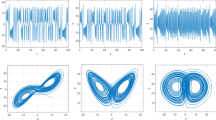Abstract
This paper deals with the problem of the discrimination between well-predictable and not-well-predictable time series. One criterion for the separation is given by the size of the Lyapunov exponent, which was originally defined for deterministic systems. However, the Lyapunov exponent can also be analyzed and used for stochastic time series. Experimental results illustrate the classification between well-predictable and not-well-predictable time series.
This work has been supported by the Deutsche Forschungsgemeinschaft, Sonderforschungsbereich 475.
Access this chapter
Tax calculation will be finalised at checkout
Purchases are for personal use only
Preview
Unable to display preview. Download preview PDF.
Similar content being viewed by others
References
ABARBANEL, H. D. I. (1996): Analysis of Observed Chaotic Data. Institute for Nonlinear Science. Springer Verlag, New York.
ARNOLD, V. I. and AVEZ, A. (1968): Ergodic problems of classical mechanics. W. A. Benjamin, New York.
BECK, C. and SCHLÖGL, F. (1993): Thermodynamics of chaotic systems. Cambridge University Press, Cambridge.
Busse, A.M., STEUER, D. and WEIHS, C. (2001): An Approach for the Determination of Predictable Time Series. Technischer Bericht 12, SFB 475, Fachbereich Statistik, Universität Dortmund, 44221 Dortmund, Germany.
BUSSE, A. M. (2003): Klassifikation von Datenreihen mit Hilfe des Lyapunov-Exponenten. Dissertation Fachbereich Statistik. Universität Dortmund. URL http://eldorado.uni-dortmund.de:8080/FB5/ls7/forschung/2003/Busse.
BUSSE, A. M. and WEIHS, C. (2004): Lyapunov exponent for stochastic time series. Technischer Bericht 37, SFB 475, Fachbereich Statistik, Universität Dortmund, 44221 Dortmund, Germany.
CASDAGLI, M. (1991): Chaos and deterministic versus stochastic non-linear modeling. J. R. Statist. Soc. B, 54, 303–328.
HASTIE, T., TIBSHIRANI, R. and FRIEDMAN, J. (2001): The Elements of Statistical Learning. Data Mining, Inference, and Prediction. Springer, New York.
KANTZ, H. and SCHREIBER, T. (1997): Nonlinear time series analysis. Cambridge University Press, Cambridge.
SANO, M. and SAWADA, Y. (1985): Measurements of the lyapunov spectrum from a chaotic time series. Physical Review Letters, 55, 1082–1085.
STOUT, W. F. (1974): Almost sure convergence. Academic Press, New York.
VDI-Richtlinie 3210 (1974, Juni). Tiefbohrverfahren. VDI, Düsseldorf.
Author information
Authors and Affiliations
Editor information
Editors and Affiliations
Rights and permissions
Copyright information
© 2005 Springer-Verlag Berlin · Heidelberg
About this paper
Cite this paper
Busse, A.M. (2005). Classification of Processes by the Lyapunov Exponent. In: Weihs, C., Gaul, W. (eds) Classification — the Ubiquitous Challenge. Studies in Classification, Data Analysis, and Knowledge Organization. Springer, Berlin, Heidelberg. https://doi.org/10.1007/3-540-28084-7_75
Download citation
DOI: https://doi.org/10.1007/3-540-28084-7_75
Publisher Name: Springer, Berlin, Heidelberg
Print ISBN: 978-3-540-25677-9
Online ISBN: 978-3-540-28084-2
eBook Packages: Mathematics and StatisticsMathematics and Statistics (R0)




